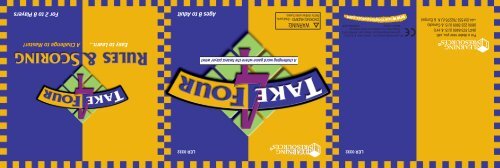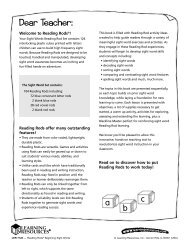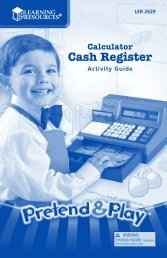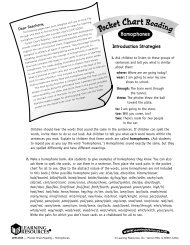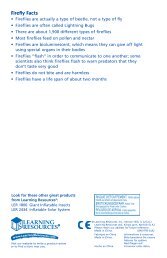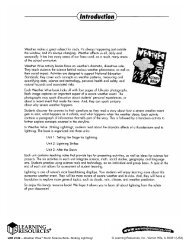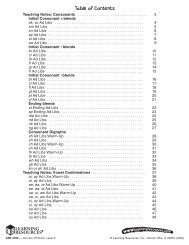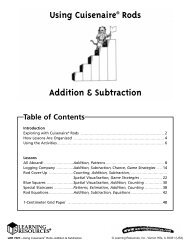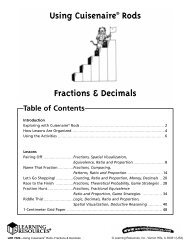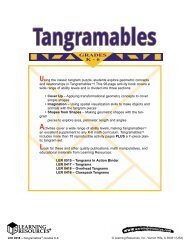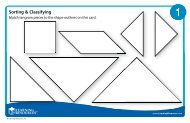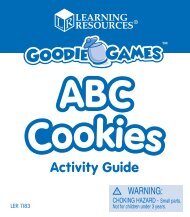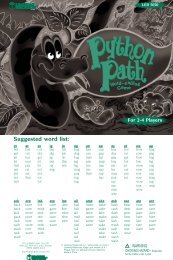You also want an ePaper? Increase the reach of your titles
YUMPU automatically turns print PDFs into web optimized ePapers that Google loves.
LER 0332<br />
LER 0332<br />
A challenging word game where the fastest player wins!<br />
Easy to Learn... A Challenge to Master!<br />
Ages 8 to Adult<br />
For 2 to 8 Players
Contents<br />
96 letter tiles, 4 joker tiles, game board, 27 bonus word cards<br />
Object<br />
Take 4 is a fast-paced, skill-testing word game for 2 to 8 people. Each player<br />
constructs a crossword puzzle using the letter tiles drawn from the pile. The object<br />
of the game is to create your crossword correctly before the other players have<br />
completed theirs. At the end of the game, the winner is the player who has the lowest<br />
score. Four joker tiles are used in standard play. The <strong>four</strong> jokers act as wild cards and<br />
can be used to represent any letter. A player may replace a joker with the actual letter<br />
and reuse that joker as a different letter in another word at any time during play.<br />
Standard Play<br />
1. Turn all tiles face down in the center of the board.<br />
2. To start, one player says, “Take 4.”<br />
3. Players each <strong>take</strong> <strong>four</strong> tiles and arrange them to make a word or words in<br />
crossword fashion (left to right or top downwards) on the grid in front of them.<br />
4. As soon as any player has arranged all <strong>four</strong> tiles into a word or crossword, that<br />
player calls, “Take 4.”<br />
5. Immediately, all players remove another <strong>four</strong> tiles from the center and add on to<br />
their crossword. The first player to use all eight letters says, “Take 4” and once<br />
again all players <strong>take</strong> <strong>four</strong> more tiles. Play continues in this fashion, with all players<br />
taking <strong>four</strong> letters on the call of the first finished, until all tiles are <strong>take</strong>n from the<br />
center.<br />
6. Once all tiles are gone from the center, the first player to complete a crossword<br />
using all his/her tiles yells, “Done.” Play stops. Round One of the game is<br />
complete and the score is calculated. See scoring instructions that follow.<br />
7. At any time during play, a crossword may be shifted on the grid (See Using<br />
Special Logo Squares) or dismantled in full or in part and rebuilt. A crossword can<br />
be constructed using any grid lines on the board.<br />
8. Discussion regarding spelling or validity of a word is encouraged while play goes<br />
on. If players do not agree on spelling or validity, play stops while one player<br />
consults the dictionary.<br />
9. Proper nouns, slang words, and abbreviations may not be used.<br />
10. During play, if a stalemate occurs and no one can call “Take 4,” players must agree to<br />
<strong>take</strong> <strong>four</strong> tiles so play can proceed.<br />
11. If there are three players, the final “Take 4” must change to “Take 1.” One tile remains<br />
unused in the center circle.<br />
Scoring and Play<br />
1. The player who calls “Done” reads the words in his crossword aloud. The other<br />
players verify its construction. Assuming the crossword is valid, and has no spelling<br />
errors, a score of zero is placed on the score sheet for that player for Round One. If<br />
the crossword is invalid, all tiles incorrectly placed must be removed from the<br />
crossword. The player receives a score of twice the sum of the numerical values of<br />
those tiles. Note: Tiles may not be rearranged, but only removed until a valid<br />
crossword remains.<br />
2. Other players, starting in a clockwise rotation from the winner, read their crosswords.<br />
For each valid crossword, the sum of the numerical values on the unused tiles is<br />
entered on the score sheet. If any of these crosswords is invalid, all tiles incorrectly<br />
placed must be removed and their face value counted with the other unused tiles.<br />
3. All tiles are returned face down to the center of the board to begin the next round<br />
of play.<br />
4. Successive rounds are played until one player reaches a total score of 50 to end the<br />
game. (The score of 50 may be changed to any value agreed upon by all players<br />
after they have become more experienced.)<br />
5. The winner of the game is the one who has the lowest total score when the game<br />
ends.<br />
6. Avid players should play as many games as the number of players so that an overall<br />
winner can be determined.<br />
Suggested Strategies<br />
1. Be sure to check thoroughly that your crossword is valid before declaring “Done.”<br />
Errors can be very expensive!<br />
2. Be careful about reconstructing your crossword in the latter stages of the round. You<br />
might get caught with extra tiles.<br />
3. When the last “Take 4” call is made, make special effort to use the tiles with the<br />
highest point value.<br />
Advanced Play (Optional)<br />
Using any or all of the following rules will present further challenge.<br />
Bonus Words<br />
Before the beginning of each round, shuffle the deck of Bonus Word Cards and<br />
distribute one to each player. Players place their Bonus Word in the Bonus Word<br />
rectangle nearest to them on the board. All players who use their Bonus Word or any<br />
anagram of it in their crossword receive a bonus score of 3 points deducted from their<br />
score for that round. At the end of each round the Bonus Cards are collected, shuffled,<br />
and distributed, one to each player.<br />
Using Special Logo Squares<br />
The playing grid has 30 special squares with the Take 4 design on them. If a player’s<br />
crossword joins two of these squares, that player’s score is reduced by 2 points. If<br />
three logos are covered, the score is reduced by 4 points, if <strong>four</strong> are covered, the score<br />
is reduced by 6 points; and so on.<br />
Words Greater Than Five Letters In Length<br />
If any player constructs a word or words greater than five letters in length, his/her score<br />
is reduced by the number of letters used greater than five; e.g. if, when the round is<br />
over, Player #3 has made the word “elephant,” consisting of eight letters, then his/her<br />
score is reduced by 3 points on that round. If Player #3 also makes the 6-letter word<br />
“grumpy,” then his/her score is reduced by an additional point.<br />
Trades<br />
Players may trade letters, one for one only, at any time during play. Possible trades<br />
should be discussed while play continues.<br />
Note: Using advanced scoring may result in a negative score on any particular round.<br />
* Original game concept by Dwight Bender, an innovative mathematics educational specialist and<br />
teacher for over 30 years.


